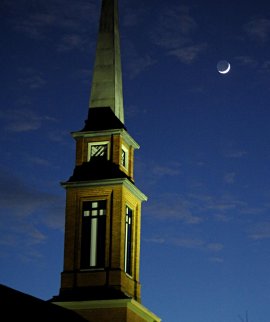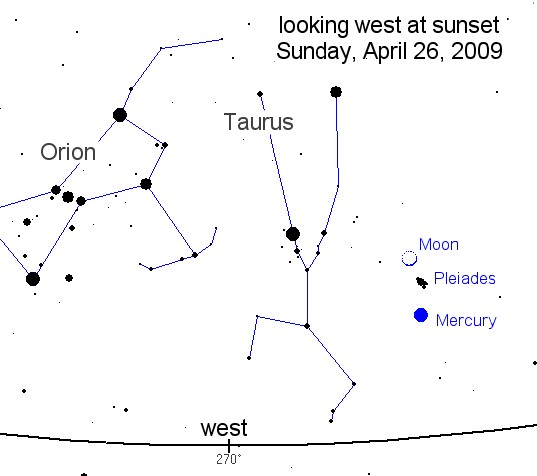|
April
24, 2009: If you're reading this at the end of the day
on Sunday, April 26th—stop! You're supposed to be outside looking
at the sunset.
 On
Sunday evening, the crescent Moon, Mercury and the Pleiades star
cluster will gather for a three-way conjunction in the western sky.
It's a must-see event. On
Sunday evening, the crescent Moon, Mercury and the Pleiades star
cluster will gather for a three-way conjunction in the western sky.
It's a must-see event.
The
show begins before the sky fades to black. The Moon pops out of
the twilight first, an exquisitely slender 5% crescent surrounded
by cobalt blue. The horns of the crescent cradle a softly-glowing
image of the full Moon. That is Earthshine—dark lunar terrain illuminated
by sunlight reflected from Earth. If the show ended then and there,
you'd be satisfied.
Right:
A crescent Moon with Earthshine over Manassas, Virginia, on Dec.
30, 2008. Photo credit: Karen Schmeets. [Larger
image]
But
there's more.
Shortly
after the Moon appears, Mercury materializes just below it. The
innermost planet has emerged from the glare of the sun for its best
apparition of the year in late April—perfect timing for a sunset
encounter with the Moon. To the naked eye, Mercury looks like a
pink 1st-magnitude star. The planet itself is not pink; it only
looks that way because it has to shine through dusty lower layers
of Earth’s atmosphere. A backyard telescope pointed at Mercury reveals
a tiny fat crescent. The innermost planet has phases like the Moon!
Next,
do nothing. Spend some quiet moments absorbing the view. As the
twilight deepens, your eyes will dark-adapt and—voilà! There are
the Pleiades.

Also
known as the Seven Sisters, the Pleiades are a cluster of young
stars about a hundred light years from Earth. They form a miniature
Little Dipper located, on this particular evening, halfway between
Mercury and the Moon. The brightest stars of the cluster are only
2nd magnitude, not terrifically bright. Nevertheless, the Pleiades
are compelling in disproportion to their luminosity. Every ancient
culture--Greek, Maya, Aztec, Aborigine, Maori and others—put the
cluster in its myths and legends. On April 26th you may discover
why, even if you cannot articulate your findings.
The
Pleiades, Moon and Mercury are all visible to the naked eye even
from light-polluted cities. Nevertheless, if you have binoculars,
use them. A quick scan of the threesome reveals a rugged moonscape
in startling detail, the rich pink hue of Mercury, and many more
than seven sisters (there are hundreds of stars in the cluster).
Still
reading? Stop! Twilight awaits.
|


